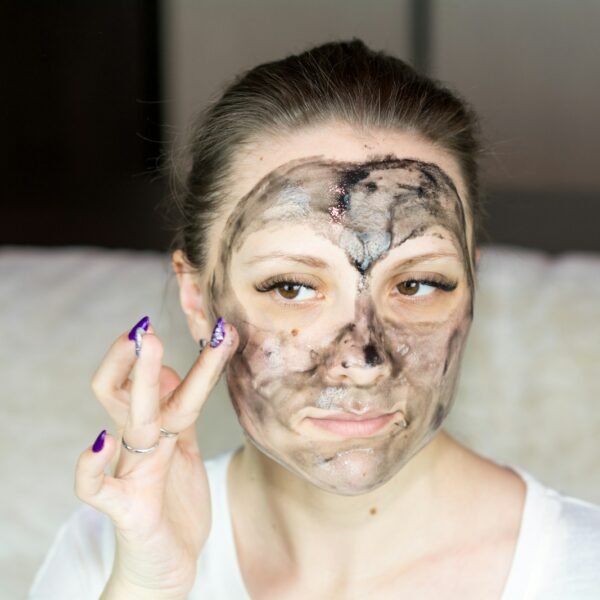With the endless lists of skincare ingredients out there, have you ever been faced with the decision of what your next skincare hero would be, that would save you from the heartache that comes with acne, rosacea or hyperpigmentation?
Then look no further! We will be taking a deep dive into the world of these two skincare ingredients: Azelaic acid vs Niacinamide. Yep! I know how difficult they are to pronounce, but trust me when I say one of these, or both might be the secret ingredients your skin might have been craving.
Without any further ado, let’s get the tea and take a deep dive into these skincare ingredients!
What is Azelaic Acid
Azelaic acid, derived from grains like barley and wheat, is renowned for its multifaceted benefits in skincare. It is an exfoliating acid that is different from the other popular acids AHAs (Alpha hydroxy acid) and BHAs(Beta hydroxy acid).
According to dermatologists at the American Academy of Dermatology (AAD), azelaic acid:
- effectively exfoliates the skin
- unclogs pores
- reduces inflammation
What is Niacinamide
Niacinamide, also known as vitamin B3, is hailed by dermatologists at Harvard Health Publishing for its diverse range of skin-enhancing properties.
This water-soluble vitamin is known for:
- strengthening the skin barrier,
- regulating oil production
- improving overall skin texture,
- reducing the appearance of dark spots for a more even complexion
- minimizing pore sizes.
Why are they important in skincare?
Azelaic acid and Niacinamide both play crucial roles in combating common skin conditions like Acne, Rosacea, and post-inflammatory hyperpigmentation making it instrumental in the skincare industry.
Azelaic acid is known to benefit those suffering from acne, rosacea, and post-inflammatory hyperpigmentation. This is due to its amazing antibacterial and anti-inflammatory properties and its wonderful ability to fade dark spots and promote a more uniform skin tone.
Niacinamide on the other hand is beneficial to those with enlarged pores, acne-prone skin, oily skin types, sensitive skin, and hyperpigmented skin due to its ability to control oil production, reduce acne breakouts, and help fade post-acne marks leading to a more even skin tone.
Azelaic Acid benefits Vs Niacinamide benefits
Let’s do an in-depth comparison of the benefits of these two skincare ingredients, Shall we?
Azelaic Acid benefits:
- Gentle Exfoliation: Unlike other harsh exfoliating acids like AHAs and BHAs, Azelaic acid gently exfoliates the skin, removing dead cells to reveal a smoother, more radiant complexion.
- Acne Control: Due to its antibacterial properties, it targets acne-causing bacteria and reduces inflammation. Azelaic acid helps prevent breakouts and minimize acne scarring.
- Anti-Inflammatory: With its amazing anti-inflammatory properties, azelaic acid calms redness and irritation, making it ideal for rosacea-prone skin, and sensitive and acne-prone skin.
- Hyperpigmentation Treatment: Azelaic acid helps in effectively fading dark spots and hyperpigmentation by acting as a tyrosinase inhibitor and inhibits melanin production for a more even skin tone.
Niacinamide benefits
- Regulates Sebum Production: Niacinamide is known for its ability to balance oil production in the skin, making it extremely beneficial for oily and acne-prone skin types.
- Minimizes Pores: Niacinamide tightens and refines the texture of the skin, thereby reducing the appearance of enlarged pores, which results in smoother-looking skin.
- Brightens and Evens Skin Tone: Niacinamide blocks the transfer of melanin within the skin, leading to a reduction in hyperpigmentation and a more even skin tone.
- Hydration Boost: Niacinamide strengthens the skin barrier, preventing moisture loss and improving overall hydration levels, making it suitable for all skin types, including dry and sensitive skin.
We now can see that both azelaic acid and niacinamide offer a range of benefits tailored to different skin types and concerns from acne to hyperpigmentation, to rosacea. Incorporating one or both of these powerhouse ingredients into your skincare routine can make a key difference in your skin’s health.
Personal Experience and Reviews of Azelaic Acid vs Niacinamide:
Having dealt with acne and hyperpigmentation personally, I can share firsthand the remarkable effects both azelaic acid and niacinamide have had in my skincare journey.
With Niacinamide, I noticed it helped fade my post-inflammatory hyperpigmentation, helped in oil control, and helped minimize the look of my pores(which I desperately needed to appear smaller).
Although I was still breaking out occasionally, the post-acne marks were fading faster than before. I then decided to incorporate Azelaic acid into my routine as well, and that was when the magic happened!!!
I noticed significantly fewer breakouts, my skin texture improved, and with this came the added benefit of fading hyperpigmentation in conjunction with Niacinamide.
I was loving my skin
But did these two completely eradicate my skin woes? Honestly, no it didn’t but it made a significant difference in my skin. I became more confident going out without make-up as I had fewer breakouts. Fewer breakouts allowed my hyperpigmentation to fade faster.
On a side note, I must say that the skin’s health goes beyond what we apply topically, it also involves what is going on internally.
This is why I wasn’t completely disappointed that I still had occasional breakouts despite incorporating these two key ingredients.
That being said, the duo of these two powerful ingredients saved my skin especially during pregnancy, as many other ingredients are to be avoided during pregnancy.
Azelaic acid vs Niacinamide concentrations:
We have covered the benefits of both ingredients and what skin type is best suited for each of them. Now let’s cover the various concentrations they come in and how to know what concentration to go with.
- Azelaic acid concentration: Azelaic acid comes in concentrations of 10%, 15%, and 20%. Azelaic acid 10% can be purchased over the counter, but you would need a doctor’s prescription for the higher concentrations.
According to a review published in the Journal of Drugs in Dermatology, concentrations of 15% to 20% are often recommended for treating acne and rosacea due to their efficacy in reducing inflammation and inhibiting bacterial growth.
Research has shown that Azelaic acid in concentrations ranging from 10% and lower, may be less effective in treating moderate to severe acne and hyperpigmentation.
- Niacinamide concentration: Niacinamide can come in a range of concentrations ranging from 2% to as high as 20%. Many studies have shown that Niacinamide is still very effective in lower concentrations of 2 to 5%.
“According to a study published in the International Journal of Cosmetic Science, niacinamide concentrations ranging from 2% to 5% have been shown to effectively improve skin texture, reduce pore size, and enhance barrier function”.
Many products on the market are usually formulated with 10%, especially in serum form. You can find 5% or less in facial cleansers or face moisturizers.
Considerations and Recommendations:
When trying to decide what concentration to go with as a beginner, there are numerous factors to consider:
- Skin Sensitivity: When selecting azelaic acid and niacinamide products, consider your skin’s sensitivity and tolerance to active ingredients.
It is best to start with lower concentrations and gradually increase as needed to minimize the risk of irritation.
- Severity of skin condition: Depending on how severe your skin condition is, that would determine what concentration to go with.
Moderate to severe acne, rosacea, and hyperpigmentation would require higher concentrations of azelaic acid, but that would require consultation with a dermatologist to get a prescription for concentrations higher than 10%.
Niacinamide on the other hand can be gotten in higher concentrations over the counter. Still, concentrations greater than 10% are usually not quite necessary, but if you want it, by all means, go for it.
Just bear in mind that an increased risk of irritation comes with higher concentration.
Key Point
Before opting for any concentration exceeding 10% of niacinamide, it’s advisable to seek guidance from a board-certified dermatologist.
Exploring Azelaic Acid vs Niacinamide Formulations
Azelaic Acid and Niacinamide come in various formulations ranging from face cleansers to serums to creams and gels.
Azelaic formulations:
- Topical Creams and Gels: Azelaic acid is commonly available in topical formulations, such as creams and gels.
- Foam cleansers and Serums: In recent years, foam cleansers and serum formulations containing azelaic acid have gained popularity
Niacinamide Formulations:
- Cleansers, Serums, and Essences: Niacinamide can be found in various skincare products such as cleansers, serums, and essences.
Typically, cleansers and essences are usually formulated with lower concentrations between 2 to 5%. Higher concentrations of 10% and above tend to be found in niacinamide serum.
- Moisturizers and Lotions: Niacinamide can also be found in many moisturizers and lotions.
Important Side Effects to Note
With all skin ingredients comes the potential for minor or severe irritation. These reactions range from mild itching, burning, dryness, skin purging, and breakouts.
In my experience, one of the noteworthy side effects of azelaic acid I experienced was temporary itching/tingling of the face and pilling of product from the face.
Key Point:
The itchiness/tingling sensation is normal with azelaic acid and will go away as the skin adapts to the new ingredient.
Tips for Choosing the Right Ingredient
Before deciding if you’re ready to incorporate one or both skincare ingredients into your skincare routine, you would need to know what your skin type is, what skin concerns you hope to target
- What Skin type do you have? – Start by understanding your skin type and the specific skin concerns you aim to address. Are you dealing with acne, rosacea, hyperpigmentation, or oily skin?
Being able to identify what your primary skincare goals are, will guide your ingredient selection process.
- Patch Testing: It is important to patch-test any new product. With stores like Sephora available almost everywhere now, it is possible to get small samples of products to try out before committing fully, if they sell the product you need.
Key Point:
Always conduct a patch test to ensure compatibility with your skin. Apply a small amount of product to the back of your ear and monitor for any adverse reactions over 24-48 hours.
How to Incorporate Azelaic Acid or Niacinamide into your routine
- Start Slow: I know the feeling of getting new products and itching so badly to try them all at once. Please don’t do that.
When introducing azelaic acid or niacinamide into your skincare routine, it is advisable to begin with the lower concentration to see how your skin responds. Gradually increase concentration as needed.
Although both ingredients are tolerable for most people, you want to be cautious to avoid skin irritation, especially if you have sensitive skin.
- Layer appropriately: Thankfully both azelaic acid and niacinamide pair well with other skincare ingredients. For better results from these products, ensure you layer products appropriately.
The rule of thumb is to start from the thinnest consistency to the thickest to ensure optimal absorption.
- Listen to Your Skin: Observe how your skin responds to azelaic acid or niacinamide.
If you experience any irritation or sensitivity, scale back usage or stop using the product.
Bottom Line – So Which Ingredient should you choose?
This is tough to answer as the answer depends on the skin challenge you want to address.
The good news is that both skincare ingredients can be used together in your skincare routine, to get the unique benefits of both.
So why have to choose when you can have the best of both worlds?
Anyway, as a quick guide:
If you are dealing with oily skin, mild acne, uneven skin tone, and enlarged pores, then Niacinamide is the girl.
If you are dealing with rosacea, moderate to severe acne, and moderate to severe hyperpigmentation, then Azelaic acid is the babe.
Hopefully, you have found this post helpful. Leave your questions or comments below 🙂





Leave a Reply